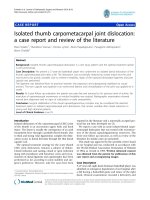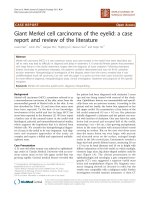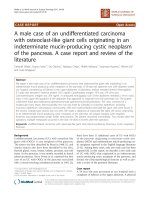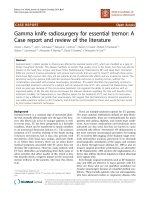Báo cáo khoa học: "Forefoot plantar multilobular noninfiltrating angiolipoma: a case report and review of the literature" pptx
Bạn đang xem bản rút gọn của tài liệu. Xem và tải ngay bản đầy đủ của tài liệu tại đây (1.55 MB, 7 trang )
BioMed Central
Page 1 of 7
(page number not for citation purposes)
World Journal of Surgical Oncology
Open Access
Case report
Forefoot plantar multilobular noninfiltrating angiolipoma: a case
report and review of the literature
Theodoros B Grivas*
1
, Olga D Savvidou
1
, Spyridon A Psarakis
1
,
Georgia Liapi
2
, George Triantafyllopoulos
1
, Ioannis Kovanis
1
,
Panagiotis Alexandropoulos
1
and Vasiliki Katsiva
2
Address:
1
Orthopaedic and Pathology department, "Thriasio" General Hospital, G. Gennimata Avenue, Magula, 19600 Greece and
2
Department
of Radiology, General Hospital of Nikea-Pireus, Greece
Email: Theodoros B Grivas* - ; Olga D Savvidou - ;
Spyridon A Psarakis - ; Georgia Liapi - ; George Triantafyllopoulos - ;
Ioannis Kovanis - ; Panagiotis Alexandropoulos - ; Vasiliki Katsiva -
* Corresponding author
Abstract
Background: Soft tissue tumors of the feet are uncommon and there have been very few reports
of large series in the literature. These tumors continue to present the clinician with one of the most
difficult problems in medicine.
Case presentation: We present a case of a large multilobular noninfiltrating angiolipoma at the
plantar surface of the forefoot. Only three cases occurring at the foot have been previously
described. We report this new case due to unusual location of the tumor, the long duration (25
years) of its existence and the unique surgical approach for the tumor excision.
Conclusion: Surgical excision is the treatment of choice and adjuvant radiotherapy is indicated in
select cases.
Background
Benign lipomatous lesions involving soft tissue are com-
mon musculoskeletal masses (almost 50% of all soft-tis-
sue tumors) though they are rare in the foot. They are
classified into nine distinct diagnoses: lipoma, lipomato-
sis, lipomatosis of nerve, lipoblastoma or lipoblastomato-
sis, angiolipoma, myolipoma of soft tissue, chondroid
lipoma, spindle cell lipoma and pleomorphic lipoma,
and hibernoma [1].
Angiolipomas are benign neoplasms and have been first
described by Bowen in 1912 [2], but were first established
as a distinct entity in 1960 by Howard and Helwig [3]. The
presence of fibrinous microthrombi is a distinctive feature
that differentiates angiolipomas from other lipomas.
Sometimes the tumor may be more aggressive and invade
the contiguous bone and adjacent soft tissues [4]. We
report here a case of angiolipoma of the foot.
Case presentation
A 47-year-old man was admitted to our department with
a soft nodular mass at the plantar surface of the forefoot
(figure 1). He complained of disabling and painful gait
until he was unable to walk and had difficulty putting his
shoes on. The patient noticed for the first time the nodule
Published: 30 January 2008
World Journal of Surgical Oncology 2008, 6:11 doi:10.1186/1477-7819-6-11
Received: 5 July 2007
Accepted: 30 January 2008
This article is available from: />© 2008 Grivas et al; licensee BioMed Central Ltd.
This is an Open Access article distributed under the terms of the Creative Commons Attribution License ( />),
which permits unrestricted use, distribution, and reproduction in any medium, provided the original work is properly cited.
World Journal of Surgical Oncology 2008, 6:11 />Page 2 of 7
(page number not for citation purposes)
25 years ago but during the preceding 12 months the size
of the nodule had increased markedly.
Physical examination revealed a tender soft-solid nodule.
A corn was developed at the overlying skin. No tingling or
numbness was present. Neurological consultation was
negative. Past medical and familiar history, as well as gen-
eral examination was negative.
Radiographs of the foot and computer tomography (CT)
demonstrated a soft-tissue lesion with no osseous involve-
ment. Magnetic resonance imaging (MRI) revealed a well-
defined mass located at the plantar forefoot with no
apparent bone infiltration, (figure 2). The sagittal T1-
weighted image revealed a lobulated, encapsulated, fatty
mass (signal intensity identical to subcutaneous fat) with
multiple hypointense nodules and septa in the subcutane-
ous layer of the forefoot, underneath the plantar aponeu-
rosis, (figure 3). The corresponding sagittal T1-weighted
contrast enhanced image, revealed that the non-fatty com-
ponent does not show any apparent enhancement, (figure
4). Finally the coronal STIR image through the phalanges
showed signal suppression of the fatty component and
high intensity of the non-fatty component, (figure 5). The
above assessment was not diagnostic for the pathology,
although the duration and the rough imaging of the nod-
ule were not implicating a malignancy.
Marginal surgical excision was performed. The nodule was
excised via a plantar approach using a longitudinal inci-
sion dictated by the morphology of the corn (figure 6).
The location of the presented lesion warranted the use of
The sagittal T1-weighted imageFigure 3
The sagittal T1-weighted image. A lobulated, encapsulated,
fatty mass with multiple hypointense nodules and septa in the
subcutaneous layer of the forefoot, underneath the plantar
aponeurosis.
The soft nodular mass at the plantar surface of the forefootFigure 1
The soft nodular mass at the plantar surface of the forefoot.
Magnetic resonance imaging (MRI) revealed a well-defined mass located at the plantar forefoot with no apparent bone infiltrationFigure 2
Magnetic resonance imaging (MRI) revealed a well-defined
mass located at the plantar forefoot with no apparent bone
infiltration.
World Journal of Surgical Oncology 2008, 6:11 />Page 3 of 7
(page number not for citation purposes)
a plantar approach. Macroscopically the nodule measur-
ing 7 × 4 × 4 cm was encapsulated and multilobular hav-
ing a vascular pedicle which was cauterized, (figure 7, 8).
The mass was totally resected without the need to sacrifice
the surrounding structures. The cut surface was solid and
yellow with a reddish tinge. In the report describing the
pathological examination, it was written the following:
"Gross pathology: The specimen 7 × 5 × 2 cm. with ill
defined margins was yellowish and elastic in consistency.
Histologically: the mass was comprised of mature adipose
and proliferated vascular tissue in various proportion
from field to field with no signs of atypia in either of the
two components, (Figure 9, 10). Many vessels were thick-
walled with collagen deposition which caused obstruc-
tion of their lumens (figure 11), while very few capillaries
demonstrated fibrin thrombi (figure 12). Adipose tissue
showed degenerative lesions with focal deposition of
acidic mucopolysaccharides (figure 13). Focal fibrosis and
plenty of mast cells were also detected in the interstitial
stroma.
The final histologic diagnosis was benign noninfiltrating
angiolipoma. The patient's postoperative course was
uncomplicated. At the 12-month follow-up no evidence
of local recurrence was noticeable.
Discussion
The pathogenesis of angiolipomas is unknown. They may
result from abnormal development of the primitive,
The nodule was excised via a plantar approach using a longi-tudinal incision dictated by the morphology of the cornFigure 6
The nodule was excised via a plantar approach using a longi-
tudinal incision dictated by the morphology of the corn.
The corresponding sagittal T1-weighted contrast enhanced imageFigure 4
The corresponding sagittal T1-weighted contrast enhanced
image. The non-fatty component does not show any appar-
ent enhancement.
The coronal STIR image through the phalangesFigure 5
The coronal STIR image through the phalanges. It showed
signal suppression of the fatty component and high intensity
of the non-fatty component.
World Journal of Surgical Oncology 2008, 6:11 />Page 4 of 7
(page number not for citation purposes)
pluripotential mesenchymal cells from which adipose tis-
sue and vascular endothelium arise or may be hamar-
tomatous in nature [5]. Other proposed etiologic
possibilities include fatty degeneration of a central
hemangioma or vascular proliferation of a congenital
lipoma [6,7].
On physical examination, angiolipomas usually present
as tender, subcutaneous nodules of white adipose tissue.
They are rarely associated with overlying skin discolora-
tion. Angiolipoma is a rare variant of lipoma and they
occur in the extremities in the spinal axis and in the neck
and head [4-6,8,9]. Only three cases occurring at the foot
have been previously described [4,8,9]. The most com-
mon symptom is a constant, dull pain with associated
neuropathies secondary to vascular engorgement and
edema, which can lead to compression of the adjacent
neural tissue [10,11]. Our patient had a tender, semi-
mobile nodule at the plantar surface of the forefoot.
The diagnosis of angiolipoma can be aided by computed
tomography (CT) or magnetic resonance imaging (MRI).
On contrast-enhanced studies, angiolipomas demonstrate
a marked enhancement as a result of their intense vascu-
larity. Noncontrast studies demonstrate the homogenous
low attenuation of a typical lipoma [11]. In our patient,
MRI detected a well-defined lesion with no infiltration
into adjacent tissues. In our case, also, the presence of
many thick-walled vessels and the degenerative lesions of
the adipose tissue to our opinion can be explained on the
bases of the "age", (long duration), of the neoplasm and
its location, which caused mechanical pressure. Beside
this estimation the mast cells, which observed in high
numbers, play a role to the consistency of the intermedi-
ate stroma.
Panoramic view (×4) depicting mature adipose and prolifer-ated vascular tissueFigure 9
Panoramic view (×4) depicting mature adipose and prolifer-
ated vascular tissue.
The mass was multilobular having a vascular pedicle which was cauterizedFigure 7
The mass was multilobular having a vascular pedicle which
was cauterized.
Macroscopically the nodule measuring 7 × 4 × 4 cm and it was encapsulatedFigure 8
Macroscopically the nodule measuring 7 × 4 × 4 cm and it
was encapsulated.
World Journal of Surgical Oncology 2008, 6:11 />Page 5 of 7
(page number not for citation purposes)
The main challenge of these otherwise benign tumors is
first to establish a correct diagnosis. They belong to a
wider spectrum ranging from benign pure lipomas, com-
posed of adipose tissue, to benign pure angiomas, com-
posed of vascular tissue. They probably lie in the middle
of this spectrum and according to the relative percentages
of adipose and vascular tissues, can be divided as lipoma-
tous or angiomatous types [8,9].
Although a presumptive diagnosis is typically made clini-
cally, these tumors with atypical clinical features may
require radiological consultation. Difficulty arises when
radiographic features are not typical of lipoma. Radiolog-
ical evaluation is diagnostic in up to 71% of cases. These
lesions are identical to subcutaneous fat on computed CT
and MRI images [1]. MRI could be a useful tool to diag-
nose local areas of infiltration [4].
Histopathologically angiolipomas are characterized by
mature adipose tissue containing copious vascular ele-
ments that vary from sinusoids, thin-walled vessels or
thick-walled vessels with proliferation of the smooth mus-
cle layer [12]. Mitotic figures are infrequent and malig-
nant changes have not been identified [13]. They vary in
color from whitish-yellow to a grayish-purple. Immuno-
(×10) Degenerative lesions of the adipose tissueFigure 13
(×10) Degenerative lesions of the adipose tissue.
(×20) Thick-walled vessel with collagen deposition and obstruction of the lumenFigure 11
(×20) Thick-walled vessel with collagen deposition and
obstruction of the lumen.
(×10) The mass was comprised of mature adipose and prolif-erated vascular tissueFigure 10
(×10) The mass was comprised of mature adipose and prolif-
erated vascular tissue.
(×20) Very few capillaries demonstrated fibrin thrombiFigure 12
(×20) Very few capillaries demonstrated fibrin thrombi.
World Journal of Surgical Oncology 2008, 6:11 />Page 6 of 7
(page number not for citation purposes)
histochemistry, if histology is not helpful, can be of some
help in the final diagnosis.
Based on studies by Dionne [14] and Lin [13], angiolipo-
mas are subdivided into two histological types: infiltrating
and noninfiltrating. Infiltrating angiolipomas are charac-
teristically not encapsulated, and they infiltrate into sur-
rounding tissue. Their clinical behavior is similar to that
of hemangiomas. Infiltrating angiolipomas are usually
diagnosed in older patients. The vast majority occur in the
lower extremities or in the paraspinal region, which can
lead to muscular pain and neural deficits [6,11,15]. In
their study of 459 lipomas, Lin and Lin [13] found that 25
(5.4%) met the criteria for angiolipoma. Two of the 25
angiolipomas were microscopically unencapsulated and
showed some degree of infiltration into adjacent tissues.
Noninfiltrating, or circumscribed, angiolipomas are
encapsulated lesions limited to the subcutaneous com-
partment. Their size almost never exceeds 4 cm. These
lesions are more common in young people, and they are
equally distributed between the sexes.
Although angiolipomas are benign lesions sometimes
they can be more aggressive and invade the contiguous
bone and adjacent soft tissues [16,17]. Contrary to lipo-
mas and angiomas, the possibility to infiltrate bone and
bone marrow renders them more susceptible to local
recurrence [4]. In these cases, only bone amputation or
postoperative radiotherapy can provide a definitive cure
[8,9].
Differentiation of angiolipomas from liposarcomas based
on imaging features is not possible some times necessitat-
ing surgical resection for definitive histological diagnosis
[18]. The differentiation is based on cellular atypia,
mitotic figures, and cellular pleomorphism, which is seen
with malignant lesions. In addition, the lipocytes of
liposarcoma resemble embryonic adipose tissue and the
vasculature of liposarcoma contains only capillaries, and
the veins are seen within the angiolipoma. Differentiation
of angiolipomas from others lipoma variants (lipomato-
sis, myolipoma, chondroid lipoma, hibernoma, spindle
cell lipoma, atypical lipoma, pleomorphic lipoma, lipob-
lastoma) and understanding the spectrum of appearances
of the various benign musculoskeletal lipomatous lesions
improves radiological assessment and is vital for optimal
patient management. Lipomatosis represents a diffuse
overgrowth of mature fat affecting subcutaneous tissue,
muscle or nerve, and imaging is needed to evaluate lesion
extent. Lipoblastoma is a tumor of immature fat occurring
in young children, and imaging features may reveal a mix-
ture of fat and nonadipose tissue. Angiolipoma, myol-
ipoma, and chondroid lipoma are rare lipomatous lesions
that are infrequently imaged. Spindle cell and pleomor-
phic lipoma appear as a subcutaneous lipomatous mass
in the posterior neck or shoulder, with frequent nonadi-
pose components. Hibernoma appears as a lipomatous
mass with serpentine vascular elements.
Benign lipomatous lesions affecting bone, joint, or ten-
don sheath include intraosseous lipoma, parosteal
lipoma, liposclerosing myxofibrous tumor, discrete
lipoma of joint or tendon sheath, and lipoma arbores-
cens. Intraosseous and parosteal lipoma have a pathogno-
monic CT or MRI appearance, with fat in the marrow
space or on the bone surface, respectively. Liposclerosing
myxofibrous tumor is a rare intermixed histological lesion
commonly located in the medullary canal of the intertro-
chanteric femur. Benign lipomatous lesions may occur
focally in a joint or tendon sheath or with diffuse villon-
odular proliferation in the synovium (lipoma arbores-
cens) and are diagnosed based on location and
identification of fat.
The treatment of both infiltrating and noninfiltrating
angiolipomas is total surgical excision. The infiltrating
type of lesion is associated with more treatment difficul-
ties. These lesions have been reported to recur after surgi-
cal excision in 35 to 50% of cases [14]. Wide local excision
with free margins is the preferred surgical procedure; in
cases of inadequate excision, radiation therapy is neces-
sary [6,11]. For noninfiltrating angiolipomas, simple exci-
sion is curative because these lesions have no tendency to
recur following surgical removal. In our patient marginal
surgical excision using a longitudinal incision was per-
formed and after one-year of follow-up the patient
showed no signs of recurrence.
Competing interests
The author(s) declare that they have no competing inter-
ests.
Authors' contributions
TBG was the principal investigator of the study, operated
upon the patient, conducted the collection of data and
involved in drafting the article. ODS involved in drafting
the article and involved in collection of the literature, SAP
helped in manuscript drafting and in the collection of the
literature, the GL performed the pathological examina-
tion, wrote the report and involved in drafting the article
and GT, IK, PA were involved in collection of the litera-
ture and drafting of manuscript. VK made the radiological
diagnosis and report. All the authors read and approved
the final manuscript.
Acknowledgements
Written consent was obtained from the patient for publication of this case
report.
Publish with BioMed Central and every
scientist can read your work free of charge
"BioMed Central will be the most significant development for
disseminating the results of biomedical research in our lifetime."
Sir Paul Nurse, Cancer Research UK
Your research papers will be:
available free of charge to the entire biomedical community
peer reviewed and published immediately upon acceptance
cited in PubMed and archived on PubMed Central
yours — you keep the copyright
Submit your manuscript here:
/>BioMedcentral
World Journal of Surgical Oncology 2008, 6:11 />Page 7 of 7
(page number not for citation purposes)
References
1. Murphy MD, Carroll JF, Flemming DJ, Pope TL, Gannon FH,
Kransdorf Mj: From the archives of the AFIP: benign muscu-
loskeletal lipomatous lesions. Radiographics 2004, 24:1433-1466.
2. Bowen JT: Multiple subcutaneous hemangiomas together
with multiple lipomas occurring in enormous numbers in an
otherwise healthy muscular subject. Am J Med Sci 1912,
1:189-192.
3. Howard WR, Helwig EB: Angiolipoma. Arch Dermatol 1960,
82:924-31.
4. Gravante G: Foot angiolipomas. The third case of the litera-
ture. Letter to the Editor. Eur Rev Med Pharmacol Sci 2006,
10:87-89.
5. Kamil Oge, Soylemezoglu F, Rousan N, Ozcan O: Spinal Angiol-
ipoma: a case report and review of the literature. J Spinal Dis-
orders 1999, 12:353-356.
6. Alvi A, Garner C, Thomas W: Angiolipoma of the head and
neck. J Otolaryngol 1998, 27:100-103.
7. Flaggert JJ III, Heldt LV, Keaton WM: Angiolipoma of the palate.
Report of a case. Oral Surg Oral Med Oral Pathol 1986, 61:333-336.
8. Wertheimer SJ, Balazsy JE: Infiltrating angiolipoma in the foot. J
Foot Surg 1992, 31:17-24.
9. Tighe C, Lynn JA: Angiolipoma of the foot. A review of the lit-
erature and case report. J Am Podiatr Med Assoc 1994, 84:85-89.
10. Reilly JS, Kelly DR, Royal SA: Angiolipoma of the parotid: Case
report and review. Laryngoscope 1988, 98(8 Pt 1):818-821.
11. Shohet JA, Simpson B, Coleman JR, Geiger XJ: Angiolipoma pre-
senting as a nasal mass. Otolaryngol Head Neck Surg 1998,
118:848-849.
12. Haddad FS, Abla A, Allam CK: Extradural spinal angiolipoma.
Surg Neurol 1986, 26:473-486.
13. Lin JJ, Lin F: Two entities in angiolipoma. A study of 459 cases
of lipoma with review of literature on infiltrating angiol-
ipoma. Cancer 1974, 34:720-727.
14. Dionne GP, Seemayer TA: Infiltrating lipomas and angiolipomas
revisited. Cancer 1974, 33:732-738.
15. Sanchez Aniceto G, Salvan Sacz R, Garcia Penin A: Angiolipoma of
the cheek: Report of a case. J Oral Maxillofac Surg 1990,
48:512-515.
16. Rivkind A, Margulies JY, Lebenstart P, Sherman Y, Robin GC: Ante-
rior approach for removal of spinal angiolipoma: a case
report. Spine 1986, 11:623-625.
17. Sakaida H, Waga S, Kojima T, Kubo Y, Matsubara T, Yamamoto J:
Thoracic spinal angiolipoma with extracanal extension to
the thoracic cavity: a case report. Spine 23:391-394.
18. Math KR, Pavlov H, DiCarlo E, Bohne WH: Spindle cell lipoma of
the foot: a case report and literature review. Foot Ankle Int
1995, 16(4):220-226.









